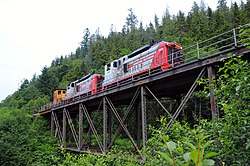Englewood Railway

Two EMD SW1200s lead a train south over the Kokish River.
|
|
| Reporting mark | ER-WFP |
|---|---|
| Locale | Vancouver Island, British Columbia |
| Dates of operation | 1917– |
| Headquarters | Woss, British Columbia |
Englewood Railway is a logging railroad on northern Vancouver Island, Canada. Headquartered in Woss, the line runs 90 km (56 mi) from Vernon Lake, through Woss, past Nimpkish Lake Provincial Park to Beaver Cove. It is the last operating logging railroad in North America.
The demand for wood products during the First World War led to the construction of a pulp mill, sawmill, shingle mill and community at Beaver Cove by Beaver Cove Lumber & Pulp Limited in 1917, which in turn brought about large-scale railway logging operations in the lower Nimpkish Valley. The active logging company was Wood & English (owned by the Nimpkish Timber Company) which established a logging camp ('Camp 8', later 'Nimpkish') and logging railway at the head of Nimpkish Lake. The logs cut from this area were hauled by an isolated logging railway, dumped into Nimpkish Lake, then towed down the lake to a reload centre where they were lifted out of the water and finally loaded onto railway cars for a short haul on a second rail line to Beaver Cove. The mill complex at Beaver Cove had a relatively short life, but in 1925 Wood & English built another sawmill across the bay from the pulp mill, and renamed the community "Englewood"—a combination of the names Wood and English. That mill ceased operation in 1941 and few signs remain of the former mills and community. After this date all logs were dumped in the Beaver Cove booming grounds for towing to mills in the Vancouver area.
In 1944 the founders of Canadian Forest Products or Canfor acquired the timber interests and logging operations in the Nimpkish Valley, which later became known as the Englewood Logging Division. By 1948, the railway had been extended 38 kilometres (24 mi) south of Nimpkish. A new logging camp was established near Woss Lake which became the headquarters and maintenance centre for the railway.
A major forest fire in 1952 and the need to salvage the burned over timber led to a further extension of the railway and establishment of the Vernon Lake logging camp and reload facility. Meanwhile, the gap between the two rail lines at Nimpkish Lake continued to exist. Recognizing that the multiple handling of logs was inefficient and costly, in 1957 Canfor built the 37-kilometre (23 mi) rail link along the east side of the lake. Englewood's logging railway line had now reached its full extent, with a 90-kilometre (56 mi) main line between Beaver Cove and Vernon and reload sites at Vernon, Maquilla, Woss, and 'Camp A'. The maintenance shops were later relocated from Woss to Nimpkish.
...
Wikipedia
